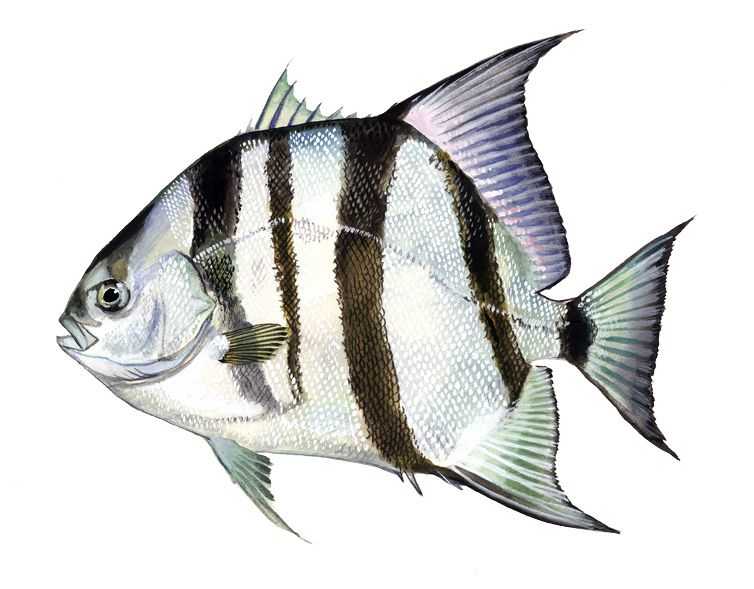Spadefish

Species Details
Chaetodipterus Faber
Ephippidae
Perciformes
Onshore, Nearshore
3 - 14 lbs.
12" - 36"
Spadefish (Chaetodipterus faber) Fish Description
The Spadefish has a disk-shaped body with a rounded snout. Its dorsal and anal fins are parallel from one another and create the illusion of being connected to the tailfin. The Spadefish’s fins also appear falcate which it creates an image of a flowing tail, similar to that of an angelfish. They have small pectoral fins which are a black gradient that slowly turns white towards the edge. Only the pectoral fins have that pattern. The dorsal, anal, and tailfin are all white with black markings at the edge of the fins. Their tail fins are square-edged and short, looking similar to a stiff broom.
Commonly, the Spadefish is silver-white in color. On its body, it has several charcoal black stripes. Some of them may appear faded. But its most prominent ones are the ones at the base of the tailfin, at the anterior of the dorsal and anal fin, and on its head – right above its eyes. The Spadefish also has a small mouth and has no teeth on the roof of its mouth.
Diet and Size
Spadefish enjoy eating small invertebrates. Some of these invertebrates include crustaceans such as small crabs and shrimps and mollusks such as clams or small squids. They also eat annelids and cnidarians such as sea anemones and smaller jellyfish. At times, Spadefish also feed on planktons loitering near a water column.
Spadefish, on average, weigh around 3-10 lbs. Its average length is around 18 inches. Usually, its growth slows down drastically after 5-10 years of age. However, some have reported seeing a Spadefish grow up to 36 inches and weigh 14 lbs.
Interesting Facts
- Spadefish have a lot of colloquial names. Some of these names include Moonfish, Angelfish, White Angelfish, Ocean Cobbler, and Three-tailed Porgy.
- Spadefish are popular gamefish because of the kind of fight they put up when people fish for them.
- They’re the type of fish that prefer to be in schools. Adult Spadefish usually are in a group of 500 other Spadefish.
- Spadefish have a lifespan of an average of only 10 years.
- When they know they’re being preyed upon, Spadefish prefer to play dead. Young Spadefish will let themselves drift along like leaves until their predator leaves them alone.
- Spadefish are the favorite food of rays, sharks, and finfish.
Fishing Techniques: How to Fish for a Spadefish
When catching a Spadefish, the most common bait to use is a clam. Spadefish love clams and when placed on a small circle hook, it’ll be a good way to catch them. The circle-hook and clam pair are the most common tools used in catching a Spadefish.
Another kind of bait to use would be the Ball Jellyfish. As one of the kinds of jellyfish that doesn’t sting, it’s easy to use them to catch the Spadefish.
Before catching them, you’ll have to look for structures in the water. Older Spadefish – especially in the open waters – prefer reefs and shipwrecks. Places where they can hide in. Most of the time, however, Spadefish prefer staying near the coastline. One thing to look for is a Mangrove Swamp. Spadefish are known to hang around there. They also stay near the beaches and harbors.
Once you’ve found a good spot, look for the Spadefish swimming nearby. Then, you can cast your line. Cast your line past them and then drag the bait through the school of Spadefish to get yourself one.
Habitat and Distribution
Spadefish are okay with brackish water, seeing that there are some offshore. However, in terms of preference, they like shallower waters. They also like waters in more tropical climates which is probably why they’re in the Western Atlantic. They’re usually found south of Massachusetts heading to the Gulf of Mexico at the southeastern part of Brazil.
Spadefish may have a preference for shallower waters to keep themselves safe from predators such as sharks and rays. They also stay near the sand to find more clams which serve as their main source of food.







